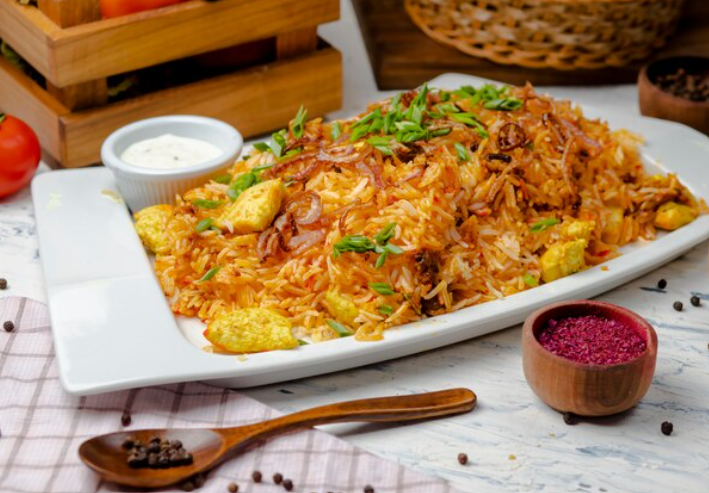Introduction
Mamaw’s Chicken and Rice Casserole is a classic, comforting dish that embodies the essence of old-fashioned home cooking. This recipe, updated in January 2024, is simple, affordable, and irresistibly delicious, making it a perfect meal to warm you up from the inside.
Ingredients
The recipe for Mamaw’s Chicken and Rice Casserole calls for simple yet flavorful ingredients. However, the specific quantities of each ingredient are not provided in the content I accessed. Generally, for a chicken and rice casserole, you can expect to use the following ingredients in approximate quantities:
- Chicken Breasts: 3 boneless, skinless chicken breasts, cubed
- Water: As needed for cooking rice
- White Rice: Typically, 1-2 cups of instant white rice
- Cream of Chicken Soup: 1 can
- Cream of Celery Soup: 1 can
- Cream of Mushroom Soup: 1 can
- Salt and Pepper: To taste
- Butter: Usually around 1 stick (can be adjusted to preference)
For variations, you might add:
- Rotisserie Chicken: Instead of raw chicken breasts
- Broccoli: A cup of fresh or frozen florets
- Cheese: 1 cup of shredded Cheddar or Pepper Jack cheese
Please note that these are estimated quantities, and you may need to adjust them based on the specific recipe instructions or your personal preferences. For precise measurements, it’s recommended to refer directly to the recipe source.
Preparation
- Preheat the oven. Begin by setting your oven to 350°F (175°C).
- Prepare the chicken. Use a knife to cube the boneless, skinless chicken breasts into 1-inch pieces for even cooking.
- Cook the rice: Follow the package instructions to cook the instant white rice. The rice will absorb the water or broth during cooking.
- Combine Ingredients: In a large bowl, mix the cooked rice, cubed chicken, cream of chicken soup, cream of celery soup, and cream of mushroom soup. Season with salt and pepper according to your taste.
- Transfer to Baking Dish: Spread the mixture evenly in a baking dish.
- Add Butter: Cut the butter into slices and distribute them over the casserole for a rich flavor.
- Bake the casserole: Bake in the preheated oven until the chicken cooks thoroughly and the casserole bubbles, usually taking about 30-45 minutes.
- Include Optional Ingredients: If using ingredients like shredded cheese or broccoli, add them as you prefer. If adding cheese, sprinkle it on top near the end of the baking time to let it melt and brown slightly.
- Serve the casserole: After baking, remove the casserole from the oven and let it rest for a few minutes before serving.
Remember, these steps are a general guide and might vary slightly based on the specific recipe or personal cooking preferences. For the best results, it’s recommended to follow the specific instructions provided in the recipe you’re using.
Presentation
The content I accessed did not provide specific presentation tips for Mamaw’s Chicken and Rice Casserole. However, based on general culinary practices for casseroles, here are some tips to beautifully present this comforting dish:
- Use an Attractive Baking Dish: A nice ceramic or glass baking dish can go straight from the oven to the table. Choose one that complements the rustic charm of a casserole.
- Garnish for Color and Flavor: Sprinkle some fresh herbs like parsley or chives on top of the casserole after baking. This adds a pop of color and a fresh flavor contrast.
- Add a Cheesy Topping: If the recipe allows, adding a layer of grated cheese towards the end of the baking time can create a deliciously golden and bubbly top.
- Serve Hot: Casseroles are best served hot. Ensure it’s piping hot when you bring it to the table to enhance its comforting aroma and taste.
- Use a Serving Spoon: A large serving spoon or spatula is ideal for scooping out portions. This ensures that the layers of the casserole are maintained as much as possible.
- Accompaniments: Serve the casserole with simple sides like a green salad or steamed vegetables to balance the richness of the dish.
- Portion Control: Cut the casserole into neat squares or rectangles for serving. This helps in maintaining the structure and makes for a pleasant presentation.
Remember, the key to a good presentation is simplicity and highlighting the dish’s inherent appeal. A chicken and rice casserole, with its creamy texture and comforting look, naturally presents well with just a few simple touches.
For more detailed information and recipes, you can visit the original article on Salt Beef Health
Storage
Storing Mamaw’s Chicken and Rice Casserole properly is important for maintaining its quality and ensuring food safety. Here are the recommended storage guidelines:
- Cool Before Storing: Allow the casserole to cool to room temperature after cooking. However, avoid leaving it out for more than two hours to prevent bacterial growth.
- Refrigeration: Place the cooled casserole in an airtight container. Store it in the refrigerator for up to four days.
- Reheating: When reheating, ensure the casserole reaches a temperature of at least 165 degrees Fahrenheit (74 degrees Celsius). This is crucial for dishes containing rice, as improperly stored and reheated rice can harbor bacteria that cause foodborne illness. Adding a few drops of water before reheating can help keep the rice moist.
- Freezing: If you want to freeze the casserole, first let it cool completely. Then, transfer it to a freezer-safe container or wrap it securely in storage wrap and aluminum foil. It can be stored in the freezer for up to three months.
- Thawing and Reheating Frozen Casserole: Thaw the frozen casserole in the refrigerator overnight. Once thawed, reheat it in the oven or microwave until it reaches the safe temperature of 165 degrees Fahrenheit.
Nutritional Insights
Expert Insights
Culinary Perspective:
- Flavor Balance: The combination of creamy soups with chicken and rice creates a comforting, rich flavor profile. The simplicity of salt and pepper allows the inherent flavors of the ingredients to shine, though additional herbs and spices could be added for complexity.
- Texture Contrast: The casserole benefits from a mix of textures—the tenderness of the chicken, the creaminess of the soups, and the softness of the rice. Adding ingredients like broccoli or a cheese topping can introduce additional textural elements.
- Versatility: This recipe is highly adaptable. Cooks can substitute different types of protein, such as rotisserie chicken, or incorporate various vegetables to enhance nutritional value and flavor.
- Ease of Preparation: The recipe is straightforward and suitable for cooks of all skill levels, making it an excellent choice for a family meal or a comforting dinner.
Nutritional Perspective:
- Protein-rich: Chicken is a lean source of high-quality protein, essential for muscle maintenance and overall health.
- Carbohydrate Content: White rice provides a quick source of energy but lacks the fiber found in whole grains. Substituting brown rice could increase the fiber content and offer a slower release of energy.
- Fat and Calories: The use of cream soups and butter contributes to the fat content, particularly saturated fat. To make it healthier, one could use low-fat soup variants or reduce the amount of butter.
- Sodium Levels: Canned soups are often high in sodium, which can be a concern for blood pressure and heart health. Opting for low-sodium soup options or homemade alternatives can help control sodium intake.
- Adding Vegetables: Incorporating vegetables like broccoli not only adds color and texture but also increases the dish’s vitamins, minerals, and fiber content.
- Dairy Additions: If cheese is added, it increases calcium content, which is beneficial for bone health, but also adds to the fat and calorie count.
Troubleshooting
History
The history of dishes like Mamaw’s Chicken and Rice Casserole is rooted in the traditions of home cooking and comfort food, particularly in American cuisine. Here’s a brief overview:
Origins in Home Cooking
- Early Influences: Casseroles, in general, have origins that can be traced back to various cultures, but the concept of a one-dish baked meal became particularly popular in the United States.
- Depression Era: During the Great Depression, casseroles became a staple in American households due to their cost-effectiveness and ability to stretch limited ingredients.
Rise of Convenience Foods
- Post-World War II: The post-war era saw a boom in convenience foods, which significantly influenced dishes like chicken and rice casserole. Canned soups, for instance, became a popular casserole ingredient due to their affordability and ease of use.
- 1950s and 1960s: This period solidified the casserole’s place in American home cooking. Recipes often called for a mix of canned soups, rice, and chicken, baked together for a simple yet hearty meal.
Cultural Significance
- Comfort Food: Casseroles like this one are often associated with comfort and nostalgia, reminiscent of family gatherings and home-cooked meals.
- Regional Variations: While the basic concept remains similar, regional variations exist across the United States, with different ingredients reflecting local tastes and available produce.
Modern Adaptations
- Health Consciousness: In recent years, there’s been a shift towards healthier versions, substituting ingredients like whole grain rice, fresh vegetables, and homemade sauces.
- Global Influences: Modern renditions also see influences from various cuisines, incorporating spices and ingredients from around the world.
Mamaw’s Chicken and Rice Casserole, with its simple ingredients and easy preparation, is a quintessential example of American home cooking. It reflects the evolution of culinary practices, from the need for economical meals to the embrace of convenience foods, and now to a balance between comfort and health-conscious eating.
conclusion
In conclusion, Mamaw’s Chicken and Rice Casserole is more than just a dish; it’s a symbol of comfort, tradition, and the evolution of American home cooking. This casserole, with its humble beginnings and simple ingredients, epitomizes the essence of a family meal that is both satisfying and nourishing.
From its roots in the economic necessity of the Depression era to its adaptation in the age of convenience foods, this dish has stood the test of time. It showcases the versatility and adaptability of home cooking, allowing for variations and modifications to suit modern dietary preferences and tastes.
Today, as we become more health-conscious, the recipe continues to evolve, incorporating fresher ingredients and healthier alternatives while still maintaining its core characteristic of being a hearty, comforting meal. It’s a testament to the enduring nature of comfort food and its ability to bring people together, evoking memories of family, home, and warmth.
Mamaw’s Chicken and Rice Casserole is not just a recipe; it’s a piece of culinary heritage, reflecting the changing trends and constants in our food culture—the importance of taste, nutrition, and the joy of sharing a lovingly prepared meal with others.
FAQs
Q: What makes Mamaw’s Chicken and Rice Casserole healthy or unhealthy? The healthiness of this casserole depends on the ingredients. While it’s rich in protein from chicken, the cream soups and butter add saturated fats and sodium. Using low-fat and low-sodium soup options, along with less butter, can make it healthier.
Q: Can whole grains be used in this casserole? Absolutely. Substituting white rice with brown rice or another whole grain like quinoa increases the fiber content and nutritional value.
Q: Is freezing this casserole an option? A: Yes, it freezes well. Just ensure proper cooling before freezing and storing in an airtight container.
Q: Would children enjoy this casserole? A: Generally, it’s kid-friendly, especially with mild seasoning and added vegetables for nutrition.

